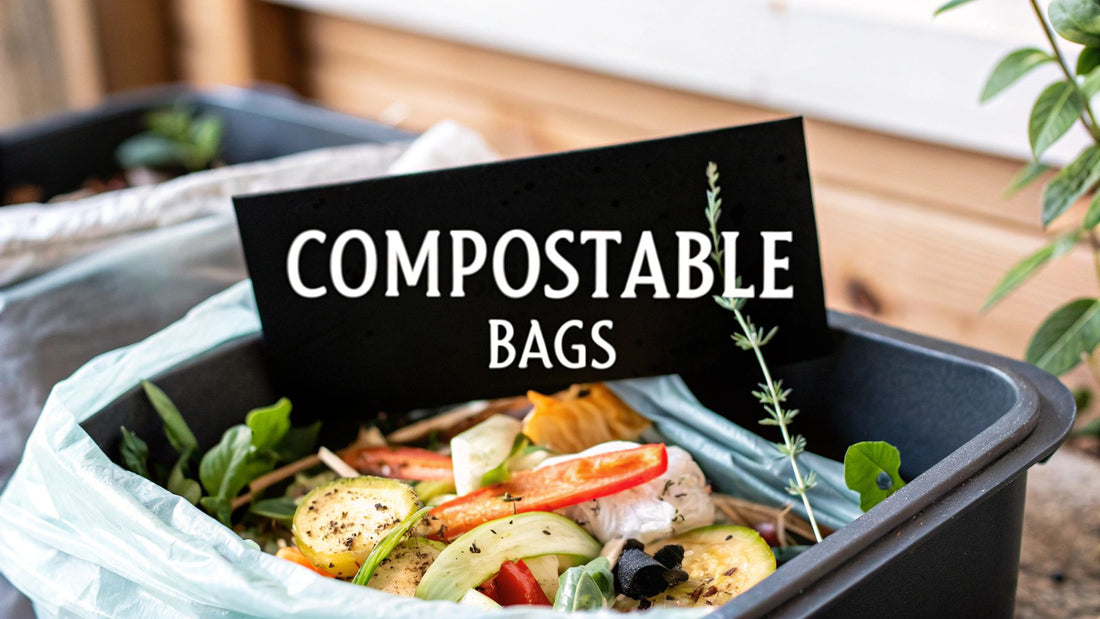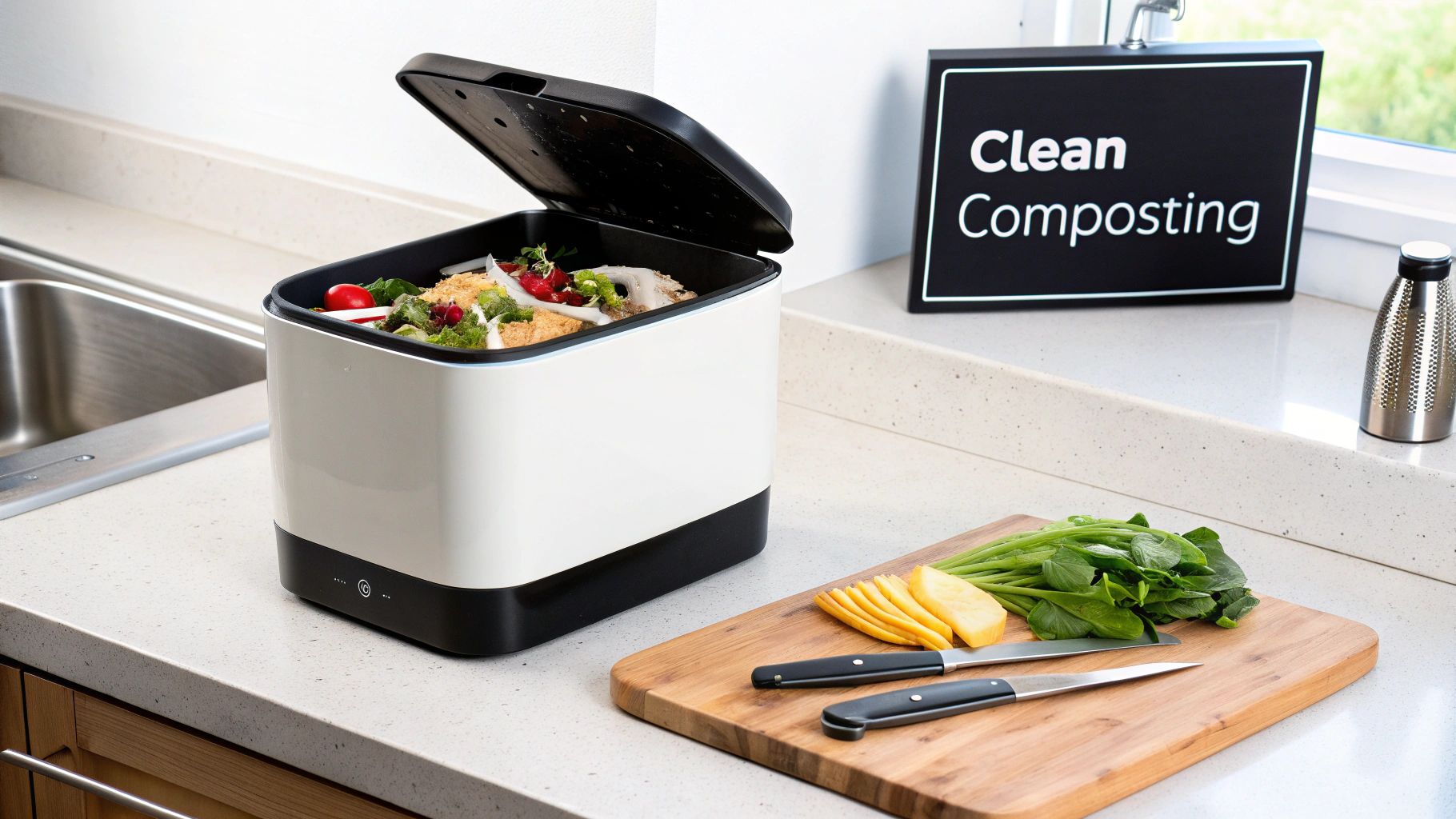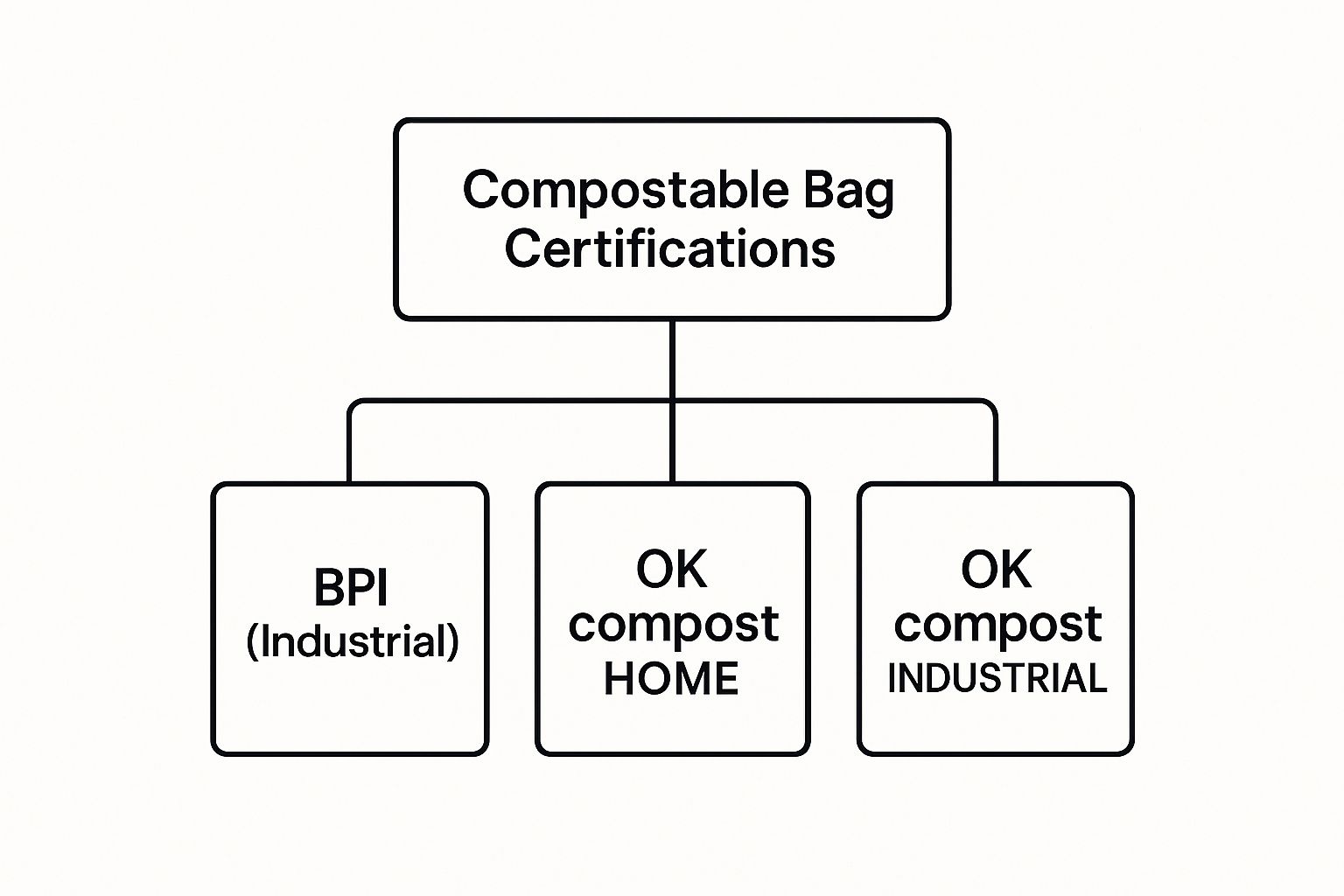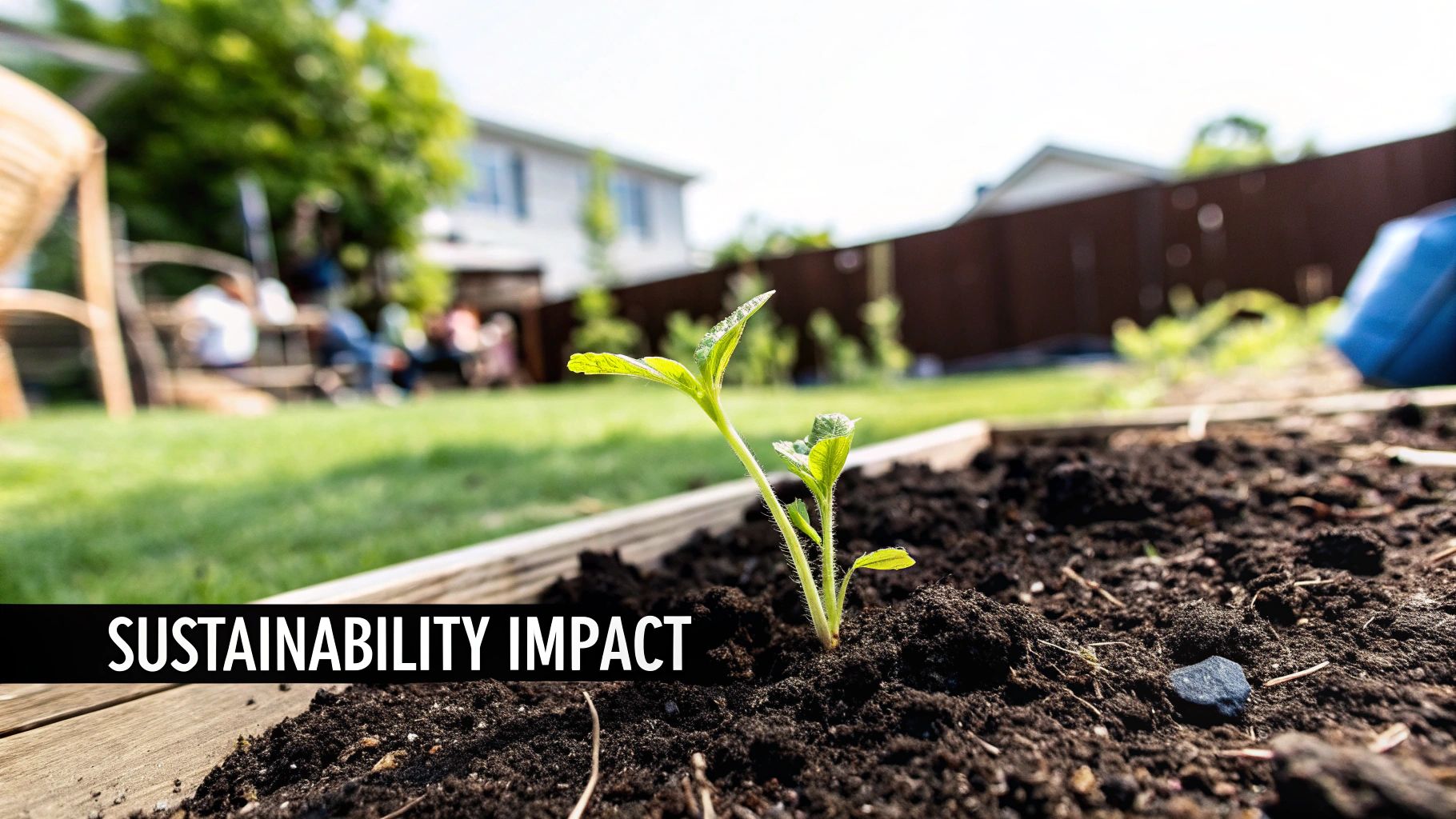
The Simple Secret to a Stink-Free, Guilt-Free Compost Bin
Share
Let's be honest—nobody wants a smelly, sticky kitchen compost bin. That "ick" factor is the number one reason well-intentioned composting efforts fail. But what if you could eliminate the mess, the smell, and the hassle entirely? Using the right compostable bags for compost bin management isn't just a small upgrade; it's the secret to transforming composting from a chore you dread into a clean, simple, and deeply satisfying part of your routine.
Finally, Composting Without the Mess

How many of us have started composting with enthusiasm, only to give up when faced with foul odors, swarms of fruit flies, or the grim task of scrubbing out a slimy container? This is exactly the problem a quality compostable bag is designed to solve. It acts as a perfect, leak-proof liner, containing all the food scraps and moisture, making the entire process feel effortless and hygienic.
Imagine a world where you're not scraping plates into a messy bin. Instead, you have a clean system that just works. It’s a small change that delivers a massive payoff, turning a frustrating task into a seamless habit. The benefits are immediate and undeniable:
- Total Odor Control: The bag locks in moisture and smells, guaranteeing your kitchen stays fresh.
- Superior Hygiene: Say goodbye to direct contact with food waste. Your caddy stays cleaner, longer.
- Unbeatable Convenience: When it’s full, you just lift the bag out and drop it into your outdoor compost pile or municipal green bin. Done.
Join the Shift to Smarter, Sustainable Solutions
This move toward cleaner composting isn't just a kitchen-by-kitchen trend; it's a powerful global movement. Both consumer demand and new environmental regulations are fueling the explosive growth of the compostable bag market.
In 2023, the market was valued at an impressive $374 million, and it's projected to surge past $610 million by 2030. This isn't just a statistic; it's proof of a profound shift in mindset. People are demanding sustainable options that make it easier to live an eco-friendly life without compromise.
If you're ready to get started or just want to brush up on the fundamentals, there's some excellent educational information on compost that provides a solid foundation. This guide will empower you to choose and use bags that truly work, making your commitment to composting feel both effortless and rewarding.
Compostable vs. Biodegradable: The One Thing You Must Get Right
Walking down the "eco-friendly" aisle can feel like navigating a minefield of misleading claims. You'll see words like "biodegradable" and "compostable" used interchangeably, but for your compost bin—and for the health of our planet—they are worlds apart.
Understanding this single distinction is the most critical step you can take to ensure your composting efforts actually help, not harm.
A genuinely compostable bag is designed to behave like an apple core. Once it hits the compost pile, it becomes food for microorganisms. It breaks down completely in a specific, controlled timeframe, leaving behind nothing but nutrient-rich humus that regenerates the soil.
Now, a product labeled "biodegradable" is a completely different beast. It’s more like a log in a forest. Yes, it will break down eventually, but that process is totally undefined. It could take decades or even centuries, and worse, it might leave behind toxic residues or microplastics that poison the very soil you're trying to build.
Why "Certified Compostable" is the Only Choice That Makes Sense
The word biodegradable is, frankly, a useless marketing term. It has no regulated standard or timeline. A plastic water bottle will eventually biodegrade, but you’d never dream of tossing it in your compost bin. That’s how vague the claim is.
On the other hand, compostable is a certified, scientifically verified standard. For a bag to earn that label, it must pass rigorous third-party testing to prove it will completely break down into natural elements in a proper composting environment, without leaving a trace of anything harmful. It’s a guarantee of environmental safety and performance.
Make no mistake: "Compostable" products are designed to become soil. Most "biodegradable" products are just plastic designed to fall apart into smaller, more dangerous pieces.
Using anything less than certified compostable bags for compost bin use will sabotage your entire project. When you introduce the wrong kind of bag, you're introducing a contaminant that ruins the delicate balance of your compost. You'll end up with a pile of plastic confetti instead of the rich, black gold your garden craves.
To master this crucial difference, explore the differences between compostable and biodegradable bags in more detail. Arming yourself with this knowledge makes you a powerful consumer and ensures your efforts contribute to a truly circular system, turning waste back into a vital resource for the earth.
How to Spot Certified Bags That Actually Work
Let's be honest, the world of "eco-friendly" products is rife with greenwashing. But when it comes to compostable bags, there's a simple, foolproof way to separate the real deal from the phonies: certification logos. Think of them as your seal of trust—an ironclad guarantee that the bag will fully decompose and not just linger in your compost pile forever.
These logos are not marketing fluff. They signify that a bag has passed stringent scientific tests to prove it can decompose within a specific timeframe, leaving absolutely nothing toxic behind. It’s the single most important feature that distinguishes a truly compostable bag for your compost bin from a greenwashed piece of plastic.
This infographic is a perfect visual guide for what to look for.

As you can see, the key is to match the bag's certification to your specific composting method. A bag engineered for a high-heat industrial facility simply will not break down in your backyard bin.
Decoding the Certification Logos
Your mission, should you choose to accept it, is to become a packaging detective. Flip the box over and hunt for these official logos. Vague claims like "earth-friendly" or "biodegradable" without a certification to back them up are red flags.
To make it easy, here is your definitive cheat sheet for the most trusted certifications on the market.
Compostable Certification Cheat Sheet
| Certification Logo | What It Means | Best For (Composting Environment) |
|---|---|---|
| BPI | The gold standard in North America. It proves the bag will break down in a commercial facility. | Industrial / Commercial Composting |
| TÜV AUSTRIA (OK compost INDUSTRIAL) | The European equivalent of BPI, also for commercial composting. | Industrial / Commercial Composting |
| TÜV AUSTRIA (OK compost HOME) | This is the one you need for backyard composting! It means the bag breaks down at lower temperatures. | Home / Backyard Composting |
Knowing the difference is non-negotiable. If you toss an "Industrial" certified bag into your home compost pile, it will stubbornly refuse to break down, leaving you with frustrating, plastic-like fragments months later. To understand the science behind this, it's worth reading more on whether compostable bags are really compostable.
Pro Tip: Always demand to see the logo. If a brand makes a claim but doesn't show the certification, walk away. Genuinely compostable products are proud to display their credentials.
Once you know what to look for, you can shop with absolute confidence. You're no longer just hoping a product works—you're choosing one that is scientifically proven to do the job right.
How Plant-Based Materials Miraculously Turn into Soil
Have you ever stopped to wonder how a bag made from corn can simply vanish into your garden soil? It feels like magic, but it's actually brilliant, nature-inspired science. The process is a perfect cycle: turning plants into a durable, useful material and then letting nature’s own recycling crew turn it back into earth.
The journey begins with renewable resources like corn or sugarcane. Starches and sugars are extracted and fermented to create a biopolymer called Polylactic Acid (PLA). This remarkable material is the primary building block for the high-quality compostable bags for compost bin you find today.
Think of PLA as a long chain of molecules. When that PLA bag lands in a compost pile, it’s like ringing the dinner bell for an army of microscopic organisms—bacteria and fungi. These tiny helpers possess the exact enzymes needed to snip apart those molecular chains and digest them.
The Science of Disappearing
For this decomposition to happen efficiently, the compost environment needs to be just right.
- Microorganisms: These are the MVPs, the invisible workforce doing all the heavy lifting.
- Heat: A healthy, active compost pile generates its own heat—often exceeding 140°F—which supercharges the breakdown process.
- Moisture: Water is crucial. It allows the microbes to move around and effectively break down the material.
- Oxygen: Proper airflow fuels the right kind of bacteria, ensuring an odor-free, efficient process.
When these conditions are met, the microbes feast on the PLA, breaking it down into its most basic components: water, carbon dioxide, and organic biomass. That biomass is the prize—the dark, nutrient-rich compost that gardeners call "black gold." Unlike a traditional plastic bag that shatters into toxic microplastics, a certified compostable bag truly becomes one with the soil.
If you're fascinated by the different plant-based ingredients, you can dive deeper into what compostable bags are made of.
PLA is revolutionizing sustainable packaging. It’s projected to make up about 31.6% of the entire compostable packaging market by 2025. Why the boom? Because it comes from plants and can fully return to the earth in about 180 days under proper composting conditions.
When you think about it, the whole process is a perfect, elegant loop. A farmer grows corn, which becomes a bag. You use that bag for your kitchen scraps, and then it all breaks down into compost that helps grow more plants. It’s a powerful, sustainable cycle that you can start right in your own kitchen.
Pro Tips for a Flawless Composting Experience
Congratulations—you’ve chosen the right certified compostable bag. Now, let’s make sure you get the clean, easy experience you were promised.
Unlike a lifeless plastic bag, a compostable bag is designed to break down. That’s its superpower. This means it’s actively responding to the moisture and heat from your food scraps. With a few simple habits, you can ensure your bag stays strong and leak-proof until you’re ready to take it out.
Think of your bag like a leaf in early autumn. It's still performing its job perfectly but is primed to start decomposing the moment it hits the ground. Your mission is to keep it "on the tree" until you're ready. By managing the environment inside your caddy, you can eliminate leaks, tears, and odors before they even have a chance to start.
Adopting these good habits will make all the difference, proving that this eco-friendly switch isn't just easy—it's superior.
Create the Perfect Bin Environment
Your first step is setting your bag up for success. The bin you use and what you put inside directly impact how well your bag performs.
A ventilated compost bin is your greatest ally. Those small holes are not just for aesthetics; they allow critical airflow, which lets moisture evaporate. This simple design feature dramatically reduces condensation—the "sweating" that is the number one cause of weakened bags.
Here's a bonus: a ventilated bin is an odor-free bin. The aerobic (oxygen-loving) microbes that thrive in this environment don't produce the same stinky gases as their anaerobic counterparts. It's better for the bag and a game-changer for your nose.
Another pro move? Let hot food cool down before you toss it in. Steam from fresh coffee grounds or leftovers creates a sauna inside the bag, accelerating its breakdown. A few minutes on the counter is all it takes.
Smart Habits for a Mess-Free Routine
Beyond the bin itself, a few simple routines will completely eliminate any potential composting headaches.
The single most important habit is to change the bag regularly. Don't wait until it’s overflowing and has been sitting for a week. The golden rule is to swap it out every 3-5 days, even if it isn't full. This prevents food from turning into a soggy, bag-weakening mess.
Here are a few more tips from the pros:
- Absorb Excess Liquid: Dealing with wet items like watermelon rinds? Toss a used paper towel or a scrap of cardboard into the bottom of the bag first. It will act like a sponge.
- Mind the Sharp Edges: Be cautious with pointy bones or skewers. If you must compost them, wrap them in a paper napkin first to prevent punctures.
- Double Up for Heavy Loads: If you know you're about to have a ton of heavy or wet scraps—like after carving pumpkins or shucking corn—just use two bags. It's cheap insurance against any spills.
Why Your Choice Is a Powerful Act for the Planet

It’s easy to dismiss choosing a compostable bag as a small, insignificant decision. But that one simple action is a powerful vote for a healthier planet. You’re doing far more than keeping your kitchen tidy—you are actively participating in a vital environmental solution.
Every single time you use a compostable bag for your compost bin, you are diverting organic waste from a landfill. When food scraps are buried in a landfill, they decompose without oxygen and release methane, a greenhouse gas over 25 times more potent than carbon dioxide at warming our planet. Composting single-handedly stops this destructive process in its tracks.
But your impact doesn't just prevent harm—it actively creates good.
Building Healthier Soil and a Greener Future
The compost you help create is a superfood for the earth. It enriches soil with essential nutrients, drastically reducing the need for chemical fertilizers that pollute our waterways. This rich, living soil grows stronger plants, holds more water to fight drought, and builds a more resilient and sustainable food system for everyone.
By choosing to compost, you transform kitchen "waste" from a problem into a precious resource. You are closing the loop, creating a circular economy where materials are regenerated instead of thrown away.
And you are not alone. Your choice is part of a massive global shift. The market for compostable bags is growing exponentially, with the shopping bag segment alone projected to be worth an astounding $1.5 billion by 2025. You can find more details about this growing market on archivemarketresearch.com.
This isn't just a fleeting trend; it's a movement powered by millions of consumers like you demanding smarter, more sustainable solutions. Your choice sends a clear message and adds real momentum to a future that benefits us all.
Your Compostable Bag Questions, Answered.
It's natural to have questions when adopting a new, better habit. To ensure you feel completely confident using compostable bags for your compost bin, I’ve answered the most common questions people ask. My goal is to eliminate any confusion so you can start your journey on the right foot.
Think of this as your expert troubleshooting guide. Once you understand the "why" behind how these bags perform, you'll be a composting pro in no time.
Can I Use These Bags in My Backyard Compost Pile?
Excellent question! The answer is: only if they are specifically certified for it. You must look for a bag with a "HOME" compostable certification, such as the OK compost HOME seal from TÜV AUSTRIA.
Bags certified only for "Industrial" composting (like those with just a BPI logo) require the intense, sustained heat of a large-scale commercial facility to decompose. Your backyard pile simply can't reach those temperatures. Tossing an industrial-only bag in your home compost will leave you with stubborn, plastic-like fragments months down the line.
Why Do My Bags Sometimes Get Weak or "Sweat"?
If you've noticed your bag feeling a bit damp or flimsy after a few days, that's not a flaw—it's a feature! It’s the first sign that the bag is doing exactly what it was designed to do: begin decomposing. The moisture and microbes from your food scraps are kicking off the natural process.
Here’s how to easily manage it and prevent any messes:
- Change the bag every 3-5 days, regardless of how full it is. This is the #1 way to prevent moisture buildup.
- Let hot items cool first—like coffee grounds—and be mindful of sharp objects.
- Use a ventilated bin. This is a non-negotiable for the best experience, as it allows moisture to escape.
- Double up when you know you have a lot of wet scraps, like juicy fruit or watermelon rinds.
What Happens if a Compostable Bag Ends Up in a Landfill?
This is a critical point. A compostable bag needs oxygen and microbes to perform its environmental magic. A landfill is a sealed, oxygen-deprived tomb.
In a landfill, a compostable bag cannot break down as intended. Instead, it may decompose anaerobically (without oxygen), a process that can release methane—a potent greenhouse gas. The incredible environmental benefit is unlocked only when the bag is sent to a proper composting facility or placed in a home compost pile.
Ready to transform your composting routine from a messy chore into a clean and easy habit? terravera offers certified compostable bags that are strong, reliable, and engineered to turn your food scraps back into nutrient-rich soil, exactly as nature intended.
